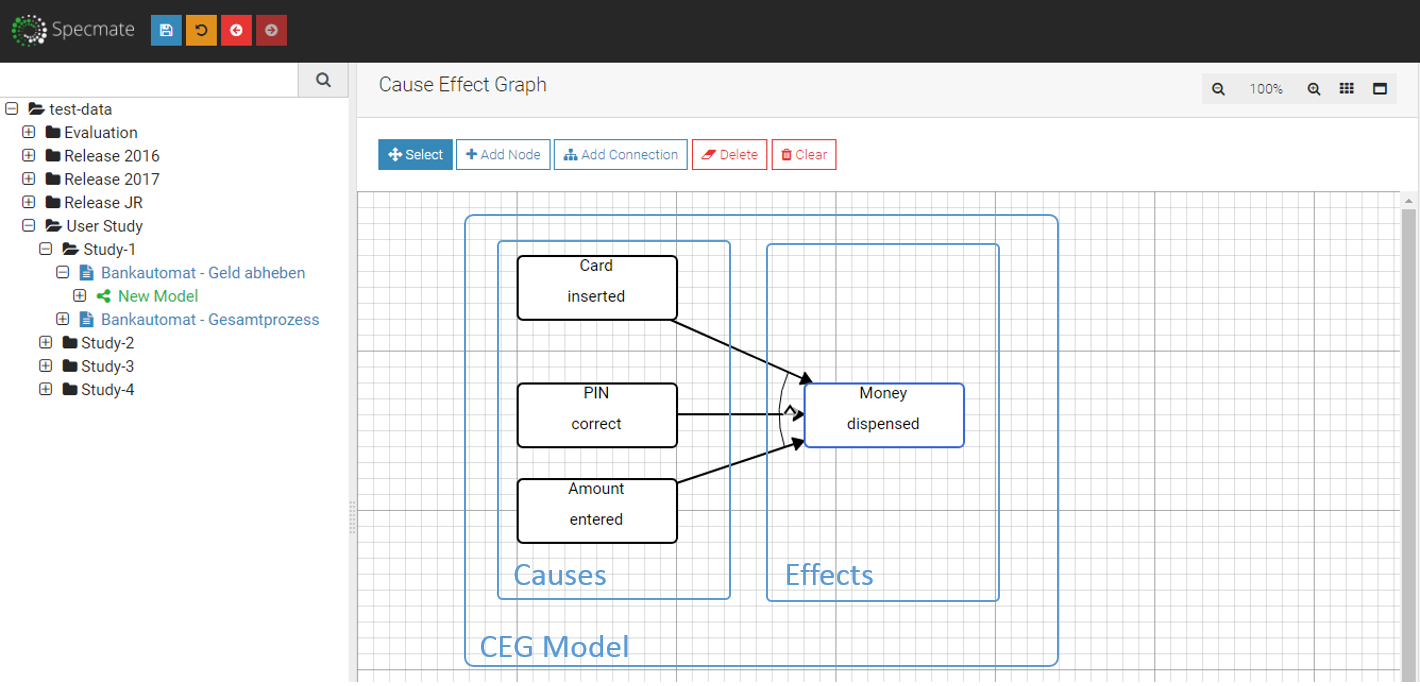OTTERs and the Theory of Automatic Testgeneration
Creating test cases by hand can be a lot of effort. It takes time, and so costs plenty of money. It is estimated that testing on average costs roughly 50% of the project budget.So maybe, we could try and skip it? Well, we still need to test and, among other things, make sure that the system behaves in the way we specified. But maybe we can develop an automatic method for creating tests? And this is the core idea: Why not use the specification to generate the tests?
Detecting Cause-Effect Relations in Natural Language
Anyone who has used a recent version of Specmate might has already seen an amazing new feature. In the overview screen of any Cause-Effect-Graph is now an anoccurus little button titled “Generate Model”. Clicking this button will trigger a chain of systems, that is capable of using natural language processing to turn a sentence like
If the user has no login, and login is needed, or an error is detected, a warning window is shown and a signal is emitted.directly into a CEG, without any additional work from the user:
 In this article we will do a deep dive into this feature, have a look at the natural language processing (NLP) pipeline required to make such a system work, see different approaches to implement it, and figure out how to garner the power of natural language processing for our goals.
In this article we will do a deep dive into this feature, have a look at the natural language processing (NLP) pipeline required to make such a system work, see different approaches to implement it, and figure out how to garner the power of natural language processing for our goals.
Light-weight Requirements Modelling and Test Case Generation: Try it yourself!
Automatically generating test cases from requirements?
We show you how. For this, we created a new way to create lightweight models for requirements. The advantage of lightweight models over text: These models can automatically generate test cases. How awesome is that? Check out our youtube demo to see the system in action: [embed]https://www.youtube.com/watch?v=PlaOzUmVIcM[/embed] You can find more information in two blog posts: Part 1 and Part 2. Or, check out our live demo and try it yourself:How to automate Test-Design with Specmate – Part 2: End-to-End Testing of Business Processes
This article is a sequel to our blog post Structured Test-Design With Specmate – Part 1: Requirements-Based Testing published by my colleague Maximilian. So far, Maximilian introduced you to our tool Specmate - a tool that helps you to automate your test-design. He explained how to model requirements using cause-effect-models and how to automatically generate test specifications based on them. However, Maximilian told you only half the story (I’m sure you were already guessing that based on the Part 1 in the title. ;-) ): Not all requirements are like the ones in his examples. Many requirements are of a different nature and can’t be specified easily using cause-effect models. In this post, I’ll demonstrate the second way of modeling requirements in Specmate: Business processes. Furthermore, I show how to generate automatically end-to-end tests based on these business processes.
Structured Test-Design with Specmate – Part 1: Requirements-based Testing
In this blog post I am going to introduce Specmate, the result of a research project I have been involved into. It is an open-source tool to automate test-design, among others. This is the first post of a series in which I am going to show you some of the ideas behind Specmate.
What is test-design and why does it matter?
Test-Design is the activity to come up with the right test-cases for a piece of functionality. But what are the right test-cases? There are many criteria, depending on your focus. For me, there are two main points:- First, they should test the right content. That means, they relate to the requirements for this functionality and cover every aspect that the requirements talk about. They should hence be able to find faults: deviations of the implementation with respect to the specification.
- Second, they should be feasible. That means, it should be possible to execute the test-cases without wasting resources.




